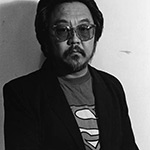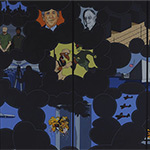An American Artist
This Module's Related Archives:
Toku Shimomura Diary
History as Art: Japanese Incarceration
Roger Shimomura Chronology
Contributors
VAAAMP
Curated Paths
Artists
Tags
Art Educators
During the course of his distinguished career, Roger Shimomura has consistently used his art to expose racial stereotypes, particularly those confronting Asian Americans. Shimomura, who originally trained as a graphic designer at the University of Washington (BA, 1961) and who later studied painting at Syracuse University (MFA, 1969), has developed a prolific and varied artistic practice, which includes painting, printmaking, and performance incorporating sound, video, music, and dance.
 Born in Seattle to American parents of Japanese descent, Shimomura and his family were forced to abandon their home and take up residence at Camp Minidoka in Hunt, Idaho, at the outbreak of World War II. Although quite young at the time, Shimomura found his experience at the incarceration camp transformative and has reflected on its significance in many of his bodies of work including Minidoka (1978– 79); Diary (1980 83); Seven Kabuki Plays (1985–86); An American Diary (1997); and Minidoka on My Mind (2006–10). A key source for the artist has been the diaries that were kept by his paternal grandmother, Toku Shimomura, which he had translated into English in the early 1980s.
Born in Seattle to American parents of Japanese descent, Shimomura and his family were forced to abandon their home and take up residence at Camp Minidoka in Hunt, Idaho, at the outbreak of World War II. Although quite young at the time, Shimomura found his experience at the incarceration camp transformative and has reflected on its significance in many of his bodies of work including Minidoka (1978– 79); Diary (1980 83); Seven Kabuki Plays (1985–86); An American Diary (1997); and Minidoka on My Mind (2006–10). A key source for the artist has been the diaries that were kept by his paternal grandmother, Toku Shimomura, which he had translated into English in the early 1980s. Shimomura’s recognition of the powerful undertones of racism in American culture became particularly acute in the Midwest, where largely homogenous populations made Asian features stand out. A professor of art for thirty-five years at the University of Kansas (1969–2004), Shimomura thrived in this academic atmosphere, where he received numerous accolades. It was in this environment that he found the support and motivation to create a diverse body of work that interrogates the complexity of bi-cultural identity and cultural prejudices, seeking to dismantle them.
Shimomura’s recognition of the powerful undertones of racism in American culture became particularly acute in the Midwest, where largely homogenous populations made Asian features stand out. A professor of art for thirty-five years at the University of Kansas (1969–2004), Shimomura thrived in this academic atmosphere, where he received numerous accolades. It was in this environment that he found the support and motivation to create a diverse body of work that interrogates the complexity of bi-cultural identity and cultural prejudices, seeking to dismantle them. Shimomura has been sensitive to the complex nature of the thematic content of his work and also to stylistic sensibility, which he consciously employs to capture this complexity. To this end, he frequently layers pictorial idioms, such as the “look” of traditional Japanese woodblock printing, with popular cultural icons—such as famous cartoon characters, historical figures, art historical references, and current events in a single image. Appropriating cultural cliches, Shimomura asks his audience to attend to the frequently overlooked implications of those tropes and in doing so subvert our often, unconscious acceptance of the values they convey.
Shimomura has been sensitive to the complex nature of the thematic content of his work and also to stylistic sensibility, which he consciously employs to capture this complexity. To this end, he frequently layers pictorial idioms, such as the “look” of traditional Japanese woodblock printing, with popular cultural icons—such as famous cartoon characters, historical figures, art historical references, and current events in a single image. Appropriating cultural cliches, Shimomura asks his audience to attend to the frequently overlooked implications of those tropes and in doing so subvert our often, unconscious acceptance of the values they convey.  Through his performance pieces, which he meticulously documents, Shimomura combines incongruous, almost surreal elements of Western and Eastern music and material culture—Superman, Mickey Mouse, barbed wire, Japanese screens, decor, and dress. Through jarring juxtapositions, Shimomura evokes the profoundly destructive consequences of the imposition of “American” culture and political power on citizens of Japanese descent forced into internment camps during World War II.
Through his performance pieces, which he meticulously documents, Shimomura combines incongruous, almost surreal elements of Western and Eastern music and material culture—Superman, Mickey Mouse, barbed wire, Japanese screens, decor, and dress. Through jarring juxtapositions, Shimomura evokes the profoundly destructive consequences of the imposition of “American” culture and political power on citizens of Japanese descent forced into internment camps during World War II.Although Shimomura has now retired from teaching, he remains active, the subject of a host of numerous recent and upcoming exhibitions. The recipient of numerous awards and honors, including a 2011 United States Artists Fellowship, Shimomura has deposited his papers at the Smithsonian Institution’s Archives of American Art.
| Previous page on path | Roger Shimomura, page 1 of 22 | Next page on path |
Discussion of "An American Artist"
Add your voice to this discussion.
Checking your signed in status ...